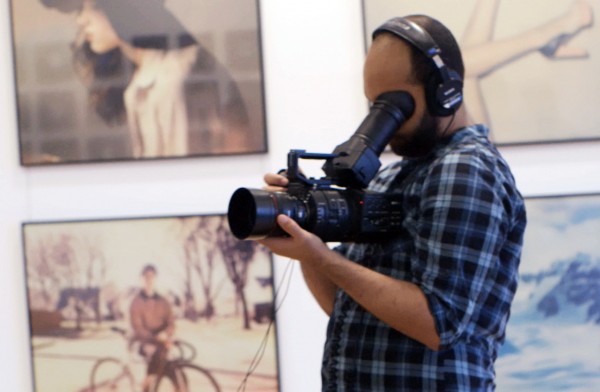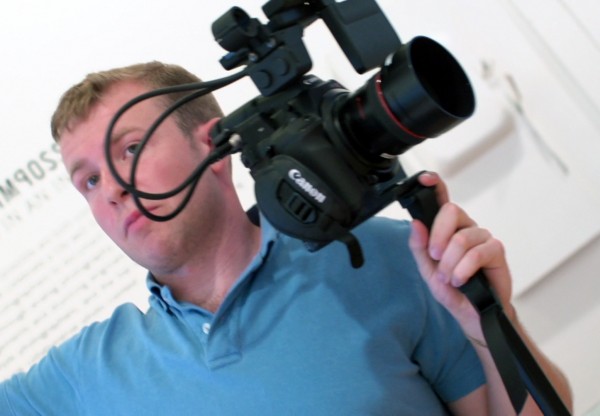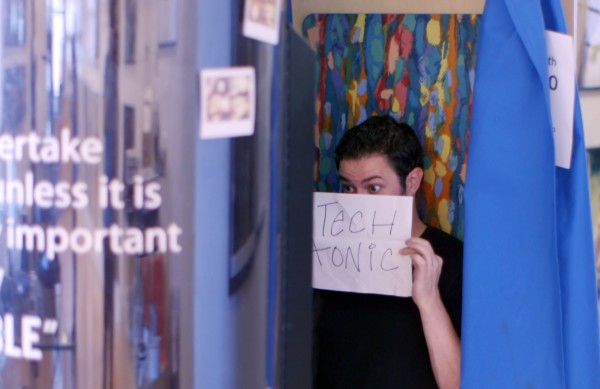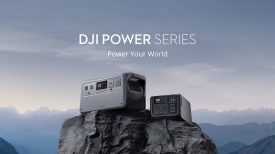Guest post by David Fazekas:
I recently purchased a Sony NEX-FS700 and have been finding any excuse to use it. I even use it around the house to record the most mundane things, which of course look AWESOME at 240fps – pouring hot water in a tea cup, lighting a match, my wife giving our baby a kiss. So when my senior producer, Jonathan O’Beirne, here at Reuters TV came to me with the idea of doing a Tech Tonic on The Impossible Project and its new Instant Lab project, my first thought was – great idea! Second thought, perfect video to use the FS700.
Canon was also kind enough to lend us a Canon C300 for a couple of weeks, which I thought would make matching the FS700 in post much easier than if we used a Canon 5D mkII or 60D. Using these two Super 35mm sensor cameras was a huge departure from the Panasonic HPX250 ENG camera we usually use. I love the Pannys – the image that comes out of them surprises me every time. But they are definitely no match in image quality for the FS700 or C300. I was also very interested to compare the FS700 and C300 in post.

Here at Reuters TV we like to go handheld on our shoots, which I would never do with a DSLR. So for this shoot I thought I’d go hand held with the FS700, since it was easy to hold and I would be able to use my chest as a support for it like I do with the Panasonics. Big mistake. I’ll explain why later, but you can probably guess. I did bring a tripod, but planned to only use it for b-roll. My colleague, Connor Boals manned the C300 and used a monopod – much smarter.

We each used Canon EF 50mm f1.2L lenses for the shoot. This would be the first time I used Canon glass on my FS700, since I had just received my Metabones EOS to NEX adapter the week before. The adapter worked great. I actually preferred controlling the iris using the wheel on the side of the camera instead of on the lens itself like I do on my de-clicked Zeiss ZF lenses. For a picture profile on the FS700 I used Sony’s preset picture profile 4. Having only owned the FS700 for a few weeks I had not had time to fiddle around with them. Out of all the preset picture profile options I felt 4 gave me the flattest image to grade later on. On the C300 we used a picture profile customized by our engineering manager, Phil Jache. I unfortunately don’t know the specifics of what he changed.
After the shoot, we returned back to the office and I was eager to check out the footage. The thing that hit me immediately was how much better the FS700 was in low-light than the C300. The other thing that hit me was how shaky the FS700 looked and I like to believe that I have a pretty steady hand. It looked like it was being operated by a drunk. Connor’s C300 shots were much steadier and useable on the monopod. This definitely had me panicking a bit – the FS700 footage was unusable as is and the footage was of the guest, Dave Bias. If it had been of the host, Anthony De Rosa, I could work around that. So this would be the first time I used the smooth camera filter in Final Cut Pro 7, another big mistake (I will explain why later). The smooth camera filter takes a lot of time to work, so I let it go overnight. The next morning I watched the footage and I was delighted to see that it looked like it had worked. The footage looked like it was being used by a sober hand.

Once I had finished my edit, it was time to do some color correcting and try to match the two cameras. As you can guess the footage from the two cameras DID look different. The C300 had a more video/glossy look to it than the FS700. I wasn’t going to be able to match the two cameras perfectly, especially with the time I had, so I got them as close as I could. After color correcting, it was time to do some coloring.
I used Magic Bullet’s Looks, Colorista II and Mojo to grade. You usually have to be careful with using the default settings on Magic Bullet, especially Looks. They can take any realism out of the look. This was something I didn’t have to worry about on this video. This was a piece about Polaroids and its look, so I planned to make the video look like one big Polaroid. I found grading the FS700 footage much easier than the C300’s, but that might be because the C300 footage was a bit underexposed. In the end though, I was very happy with how both cameras came out.
After a day and a half of editing and grading, it was time to export. When I looked at the exported Quicktime movie file, I was terrified to see that all the FS700 shots I used smooth cam on were shakier than before I used the filter. I called over our editor extraordinaire Jonathan O’Beirne and he was as mystified as me. After doing a Google search, it appeared we weren’t the only ones facing this problem. Apparently it’s a major bug in FCP 7. Don’t look forward to Apple fixing that one anytime soon. I don’t know if it has been fixed in FCP X. The solution was to bring the footage into Motion and use the stabilizer filter. This actually worked better than the FCP7 smooth cam filter.
In the end, I was very impressed with both cameras. I just love the ergonomics of the C300. Its a great camera to use handheld, unlike the FS700 – which I learned the had way. I also love how the C300’s LCD is set-up, as a detachable option that can swivel any number of ways. The FS700’s LCD has less options – it really only has one move, turning 180 degrees. And forget about using the optional eyepiece to help stabilize the camera using it as a handheld – the viewfinder doesn’t lock hard enough to use it like that. Now, I’m not trying to make the FS700 seem like a terribly built camera because it isn’t. But compared to the C300, the FS700 is lacking in the comfort of the palm department.
How about the images from each camera? I mean, that is what we really care about right? I have to admit I like the picture out of the FS700 more. Skin tones looked a whole of a lot better out of the FS700 than the C300 in my opinion. I have never really been a fan of skin tones out of Canon’s DSLRs and they look the same to me out of the C300 – somewhat unnatural. Also, the FS700’s low-light performance worked much better than the C300’s. I’m somewhat nitpicking though as each camera is a fantastic camera to use and own, if you can afford them.
The FS700 is of course almost twice as less as the C300 and it has that going for it. Though if the price of the two cameras were the same I still think I would go with the FS700. The high frame rate is great and the ability to someday be able to upgrade to shoot at 4K are huge bonuses. I will definitely not go pure hand-held with the FS700 anytime soon again – just tripods and shoulder rigs from now on.
David Fazekas is a journalist, documentarian, father and a very sad Jets and Mets fan.
You can follow him on Twitter @nozekas
You also see more of his work on Vimeo.






